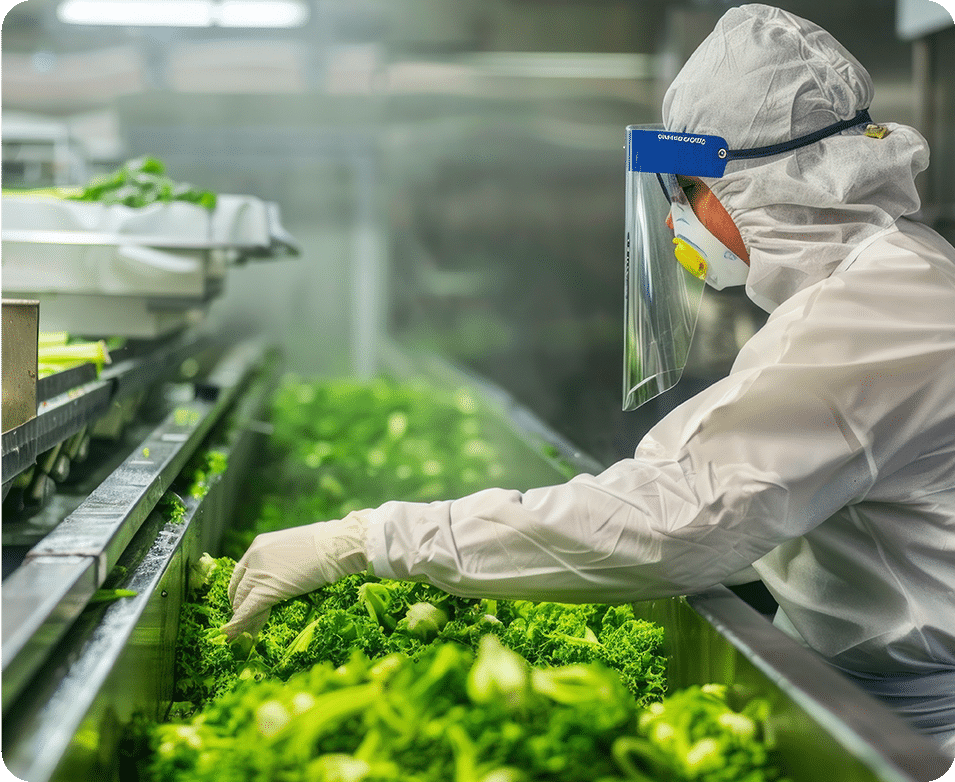April 8, 2024 1 min read

Food Manufacturing Sanitation Training: The Secret Ingredient for Quality and Safety
Industry:
Solution:

In the food manufacturing sector, striving for safety and quality is foundational to success and calls for consistent commitment at every level of the organization. Every year, millions of people worldwide are affected by foodborne illnesses, underscoring the critical importance of maintaining the highest standards of hygiene and sanitation in the food production process.
Effective food manufacturing sanitation training is fundamental to manufacturers producing safe, high-quality food products.
Key highlights:
- Critical Role of Sanitation in Food Manufacturing: Discover how food manufacturing sanitation training helps prevent contamination, safeguard food safety, and maintain high product quality across the production process.
- Economic Benefits of Training: Learn how investing in sanitation training can lead to cost savings by reducing product recalls, minimizing waste, and preventing costly downtime in production.
- Comprehensive Training Components: Explore the essential elements of effective sanitation training programs, including foundational knowledge, hands-on skills, problem-solving exercises, and continuous improvement practices.
The Importance of Sanitation in Food Industry Practices
Sanitation in food manufacturing encompasses a wide array of practices aimed at preventing contamination and ensuring that food products are safe for consumption. This includes everything from the cleaning and disinfection of equipment and surfaces to the proper handling and storage of ingredients.
The stakes of overlooking these practices are high, with the Centers for Disease Control and Prevention (CDC) estimating that 1 in 6 Americans become sick from consuming contaminated foods or beverages each year.
These statistics not only highlight the risk of foodborne illnesses but also spotlight the critical role that sanitation standards play in safeguarding public health.
The Economic Impacts of Sanitation Training
The financial benefits of investing in food manufacturing sanitation training go well beyond just meeting regulatory costs. By implementing thorough training initiatives, businesses can achieve considerable financial savings through:
- Preventing expensive product recalls
- Reducing waste
- Decreasing operational downtime caused by sanitation issues
For example, the economic toll associated with foodborne illnesses in the flour and flour-based product sectors was estimated to reach up to $258 million between 2001 and 2021, according to a study funded by the U.S. Department of Agriculture.
Businesses that place a high emphasis on sanitation and food safety training programs often gain a competitive edge, leading to increased customer attraction and the development of stronger relationships with suppliers and retailers.
This shows that investing in preventive food sanitation measures is not just more effective but also more economically sensible in the long run.
Regulatory Frameworks and Standards for Food Manufacturing Sanitation
Navigating the vast number of global and national regulations governing commercial food safety and sanitation can be daunting. Yet, understanding these regulatory frameworks is a cornerstone of effective training.
Regulations such as the Food Safety Modernization Act (FSMA) in the United States, the European Union’s General Food Law, and other international standards set the baseline for what constitutes safe food manufacturing practices.
These frameworks not only mandate the implementation of sanitation training programs but also outline the minimum requirements these programs must meet. Compliance with these standards ensures that manufacturing facilities are meeting legal obligations and upholding high standards, ensuring food safety and quality.
Food Manufacturing Training: A Pillar of Food Safety
Rigorous food manufacturing sanitation training helps educate employees on the importance of this training and how to implement it effectively.
This training should equip food manufacturing personnel with the knowledge and skills necessary to consistently and effectively implement food sanitation practices. It’s about transforming individual actions into a collective commitment to safety and quality.
Sanitation training covers a broad range of topics from understanding the microbiological principles behind food spoilage and cross-contamination to mastering the proper use of sanitizing agents and equipment. More importantly, it instills a mindset of vigilance and responsibility, ensuring that every member of the team understands their role in preventing food safety problems and protecting consumers.
Components of Effective Sanitation Training in Food Manufacturing
A food-manufacturing sanitation training program’s effectiveness is not solely determined by its ability to meet regulatory standards. At its core, it must be comprehensive, practical, and adaptable. Essential components of a robust sanitation training program should include:
- Foundational Knowledge: Employees must understand the “why” behind the practices. This includes education on the types of foodborne pathogens, their sources, and the conditions that promote their growth.
- Hands-On Skills: Practical training on the correct use of cleaning and sanitizing chemicals, equipment handling, and personal hygiene practices.
- Problem-Solving Exercises: Scenario-based training that prepares employees to identify and address sanitation issues proactively.
- Continuous Improvement: Regular updates to training content to reflect the latest in food safety research, technological advancements, and regulatory changes.
By covering these critical areas, sanitation training programs not only empower employees to perform their duties effectively but also foster a culture of safety and continuous improvement.
Online Safety Training Courses
Complete with powerful 3D animations and models, these interactive online safety training courses address common hazardous situations faced in a variety of environments and industries
View Courses
Overcoming the Challenges in Implementing Food Production Sanitation Training
Implementing effective training in the food manufacturing industry presents a unique set of challenges. These obstacles range from workforce diversity and operational variability to financial constraints and technological adoption hurdles. However, with a strategic approach, these challenges can be transformed into opportunities for enhancing manufacturing safety culture and operational efficiency.
Addressing Workforce Diversity
Food manufacturing facilities often employ a diverse workforce, characterized by a wide range of languages, educational backgrounds, and levels of technical expertise. This diversity, while a strength, can complicate uniform training efforts.
Suggested Strategies:
- Multilingual Training Programs: Develop training materials and sessions in multiple languages to ensure all employees can understand and apply the sanitation principles effectively.
- Customized Learning Paths: Offer various training formats, such as visual aids, on-the-job (OTJ) demonstrations, and digital learning platforms, to cater to different learning styles and educational backgrounds.
Navigating Operational Variability
The dynamic nature of food manufacturing processes, with frequent shifts in production demands, regulatory updates, and the introduction of new equipment, poses significant challenges to maintaining consistent training standards.
Suggested Strategies:
- Flexible Training Schedules: Implement flexible training sessions that can adapt to different shifts and production schedules, ensuring all employees receive consistent training without disrupting operational efficiency.
- Ongoing Training Updates: Regularly review and update training programs to reflect the latest industry standards, technological advancements, and regulatory requirements, keeping the workforce informed and compliant.
Managing Financial Constraints
For many food manufacturers, especially smaller operations, the costs associated with developing and implementing comprehensive training can be intimidating.
Suggested Strategies:
- Leverage Technology for Cost-Effective Training: Utilize online training platforms to provide cost-effective, scalable training solutions that can reach a wider workforce audience without the need for extensive physical resources.
- Start Small and Scale Gradually: Begin by integrating technology into existing training programs in manageable increments, allowing both trainers and employees to adapt to new tools comfortably.
- Seek Government Grants and Subsidies: Explore opportunities for financial assistance through government grants and subsidies designed to support food safety and quality initiatives such as the USDA-NIFA Food Safety Outreach Competitive Grant Program or by searching government websites such as the National Institutes of Health (NIH) grants resource or grants.gov.

Creating a Culture of Cleanliness and Safety
Ultimately, the most profound impact of effective food manufacturing training is creating a culture that prioritizes cleanliness and safety.
This shift towards a food safety culture starts at the facility’s entrance, where rigorous standards for cleanliness are established for everyone, from visitors to staff. These initial interactions set the tone for a comprehensive commitment to sanitation, underscored by the importance of handwashing and personal hygiene practices, which should be meticulously outlined and enforced to prevent any risk of contamination.
An important aspect of embedding this culture within the organization is a dual approach of comprehensive training and strong management support. Food manufacturing training should go beyond basic instruction and aim to instill a core understanding of the importance and impact of each individual’s actions on preventing foodborne illnesses and other food safety issues.
Management’s role is also pivotal in creating policy and resource allocation and leading by example to demonstrate a firm commitment to hygiene standards at their facility. When employees at all levels understand and embrace their role in maintaining high standards of food sanitation, the result is a workplace where food safety is second nature which reduces the risk and makes quality the standard.
Why Choose Vector Solutions for Food & Beverage Manufacturing Sanitation Training
Food manufacturing sanitation training is foundational to achieving food safety and quality in manufacturing, offering significant economic benefits and fostering a culture of safety and excellence. As the industry evolves, so will the methodologies for sanitation training, always aiming to safeguard public health and guarantee the superior quality of food products.
Book a demo today and see how Vector can enhance manufacturing training management.









